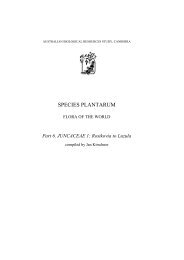Introduction - Species Plantarum Programme
Introduction - Species Plantarum Programme
Introduction - Species Plantarum Programme
You also want an ePaper? Increase the reach of your titles
YUMPU automatically turns print PDFs into web optimized ePapers that Google loves.
10<br />
SPECIES PLANTARUM — FLORA OF THE WORLD (1999)<br />
There may be genera of flowering plants which, in the opinion of the contributor, are clearly<br />
misplaced in the Brummitt system. These may, with the approval of the Executive Editor, be<br />
treated in a more appropriate family in the Flora. They should also be mentioned in the<br />
family in which they were placed by Brummitt in the form of a generic heading followed by<br />
a note on the placement in the Flora.<br />
The format for a family treatment may be seen in the following example.<br />
Thymelaeaceae Juss., Gen. Pl. 76 (1789)<br />
Type: Thymelaea Mill.<br />
THYMELAEACEAE<br />
B.L.Rye<br />
Kelleria by M.J.Heads<br />
Annual herbs to trees, usually shrubs, commonly with stringy bark, often with simple hairs.<br />
Leaves simple, entire, usually reticulate-veined; stipules absent or vestigial. Inflorescence<br />
commonly racemose or spicate to capitate. Flowers actinomorphic or rarely slightly<br />
zygomorphic, usually with a well-developed corolla-like hypanthium. Calyx of 4 or 5 or<br />
sometimes 3 or 6 sepals or lobes or rarely erose, arising at summit of hypanthium or<br />
sometimes basal. Corolla lobes (when present) as many as or more than sepals, often scalelike,<br />
inserted at throat of hypanthium or sometimes free from other floral whorls. Nectary<br />
disc or glands often present around base of ovary. Stamens 1–80, usually 2–10, inserted on<br />
hypanthium or sometimes free, often in 2 whorls; anther locules 2, parallel, longitudinally<br />
dehiscent. Ovary free, superior, 2–12-carpellate, 1–12-locular; ovules 1 per carpel,<br />
pendulous; style simple. Fruit indehiscent or sometimes a loculicidal capsule. Embryo oily,<br />
straight. [146 words]<br />
An almost worldwide family of 55–60 genera and over 500 species, concentrated in tropical<br />
and southern Africa and from SE Asia to Australia. Many genera contain toxic species. In<br />
Australia 13 species in the genera Pimelea and Wikstroemia have been reported to cause<br />
stock poisoning (S.L.Everist, Poison. Pl. Australia 691–710, 1981). Some species,<br />
particularly of Daphne and Pimelea, are cultivated as ornamental shrubs. The bark of many<br />
genera has been used locally for varied purposes including paper manufacture and, in<br />
Australia, string.<br />
The interpretation of floral structure adopted here follows L.Bunniger, Beitr. Biol. Pflanzen<br />
48: 79–156 (1972), who concluded that the hypanthium in subfam. Thymelaeoideae consists<br />
of outer axial tissue and inner tissue derived from the corolla and androecium. According to<br />
this interpretation, the calyx originates from axial tissue at the summit of the hypanthium and<br />
appears to be a continuation of the tube. The proximal part of the hypanthium, which<br />
encloses the ovary and is commonly fusiform, is referred to here as the ovary-portion, and the<br />
usually narrower distal portion enclosing part or rarely all of the style as the style-portion.<br />
G.Bentham, Thymeleae, Fl. Austral. 6: 1–39 (1873); E.Gilg, Thymelaeaceae, in A.Engler &<br />
K.Prantl, Nat. Pflanzenfam. 3(6a): 216–245 (1895); W.Domke, Untersuchungen über die<br />
systematische und geographische Gliederung der Thymelaeaceen nebst einer<br />
Neubeschreibung unter Gattungen, Biblioth. Bot. 111: 1–151 (1934); K.Heinig, Studies in<br />
the floral morphology of the Thymelaeaceae, Amer. J. Bot. 38: 113–132 (1951); Ding Hou,<br />
Thymelaeaceae, Fl. Males. ser. I, 6: 1–48 (1960); L.Bunniger, Untersuchungen über die<br />
morphologishe Natur des Hypanthiums bei Myrtales- und Thymelaeales-Familien II.<br />
Myrtaceae. III. Vergleich mit den Thymelaeaceae, Beitr. Biol. Pflanzen 48: 79–156 (1972).<br />
Amended from Fl. Australia 18: 122 (1990)












